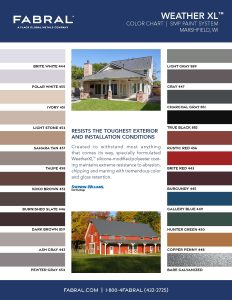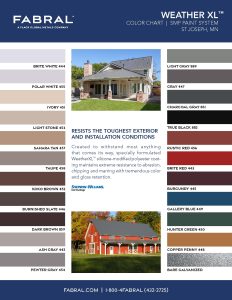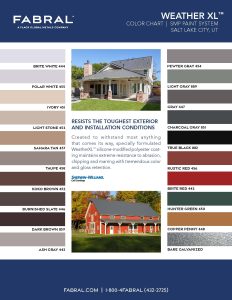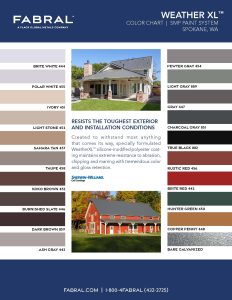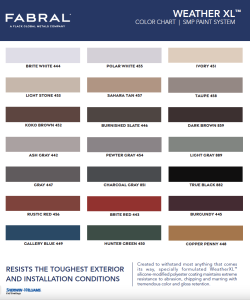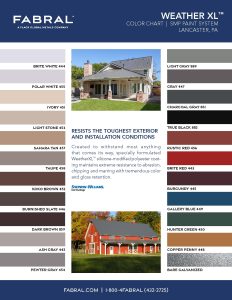
Frequently Asked Questions
What are the advantages of metal over other types of roofing?
Prefinished metal roofing is offered in a broad palette of attractive colors with long-life coatings that do not support the growth of moss, mildew or fungus. Metal panels are lightweight yet strong enough to withstand severe weather – snow easily slides off the roof. Finally metal roofing lasts longer, conserves energy and requires virtually no maintenance.
Are any special tools required?
Metal roofing and siding can be easily installed using standard hand tools such as a screw gun, hammer, metal snips, caulk gun, pliers, chalk line and tape measure. Cutting metal panels is best accomplished with an electric metal shear; however, panels may be easily cut with a circular saw with a metal-cutting abrasive blade. Standing seam roof systems require hand or mechanical seaming tools available from Fabral. See our installation instructions for complete details.
How do I properly lap exposed fastener panels?
The correct way to install an end lap condition for steel is to create a minimum 12″ lap. End lap sealant tape should be installed in the lap approximately 1″ into the lap. Fasteners should be installed approximately 2″ into the lap, ensuring that the fasteners are always to the high side of the sealant tape. This prevents any water from getting to the fastener penetrations, where it could enter the building. Ensure that fasteners are anchored into a purlin or roof sheathing. Fastening pattern should be the eave pattern, which is one fastener on each side of the rib.
Can I eliminate the plywood and just use purlins and metal panels over the trusses?
That depends. If you are installing a standing seam roof it will not provide any diaphragm action, which may have been counted on for distributing wind loads. Even if you are using a screwed down panel, there is a significant opportunity for condensation problems in residential applications. Metal panels should have CondenStop on the back side of the panels or a solid deck and underlayment to minimize condensation problems. If there are valleys, they also need solid support for the valley flashing. Consult your designer before removing a structural component like plywood.
What is the best material to use along the ocean?
The salt spray from the ocean is very corrosive to most steel panels; therefore, the best solution would be to use a painted aluminum panel in these areas.
Where do I place screws for exposed fastener applications?
A properly installed screw will be down in the flat of the panel. At this location the metal panel has solid wood right below the metal panel and good compression on the washer can be obtained. With thermal movement in the panel, the screw will be put into shear, not bending, and the hole thru the metal panel will slightly elongate. As long as this slot does not exceed the diameter of the washer, the hole will remain sealed. This is why we limit the panel length for aluminum exposed fastened panels to 16’ and limit steel exposed fastened panels to about 40’. Additionally, the diaphragm shear capacity and shear stiffness is based on the screws being installed in the flat of the panel. If screws are installed in the top of the rib, the diaphragm would be much more flexible and would not be as strong.
Do I need a rubber membrane underlayment under metal roofing panels?
A rubber membrane underlayment is always a good idea as an additional barrier against water infiltration. You should always use one under a valley condition or any other detail that is likely to be difficult to seal. A rubber underlayment is also recommended at the eave and up to at least 24″ past the exterior wall in a northern climate to help prevent water from entering the roof due to ice damming. It should also be used on very low slopes and when the metal panels are not sealed at their side laps.
Why does your installation manual show the metal wall panels held so high above the ground?
We show the panels held up above the ground level to make sure the bottom of the panels are not in constant contact with moisture, which would accelerate corrosion. To avoid contact with moisture, the panels should not be in constant contact with the ground or vegetation.
Will a metal roof make my house or building more susceptible to a lightning strike?
No. A metal roof will not make a building more susceptible to a lightning strike. Lightning will tend to strike the highest object in a given area, regardless of what that object is made of. A metal roof can actually be beneficial in the event of a lightning strike due to being a non-combustible material.
Can I install metal panels directly over my old, worn-out shingles?
Since metal weighs only 1/3 as much as shingles, you can often attach metal panels without tearing off your existing shingle roof. This eliminates the cost and problems of disposing of the old shingles. The best way to do this is to attach 1″ x 4″ or 2″ x 4″ furring strips at 24″ o/c parallel to the eave and ridge. Check local codes to determine if tearing off shingles is required in your area. Request Fabral’s Technical Bulletin #721 for additional information.
Do metal roofs sweat?
No, metal panels do not have sweat glands and do not generate any moisture. They do, however, conduct heat and cold very quickly so as the outside temperature drops the metal panels will reach the dew point temperature quicker than other materials. Also, metal panels do not absorb any moisture. As a result, when the metal panels cool down below the dew point temperature, condensation will form on the panels and since it is not absorbed it will drip off the metal panels. We now offer a product attached to the bck side of our Grandrib 3 panels called CondenStop that will absorb this moisture and minimize this potential problem. Alternately, insulation and a vapor barrier can be installed under the panels to prevent the moisture from reaching the metal panels.
How do I attach metal panels?
You may use either screws or nails—both color matched to the color of your roof. Screw fasteners are designed to go into the flat part of the panel. Nails MUST GO in the high rib of the panel. Fasteners are typically spaced 24″ o/c. The FabrOseal is the best available option as a nail and also a viable option to fasten the panel if screws are not the method to be used by the installer.
Can I use a lead pencil to mark on my metal panels?
No. Standard lead pencils, or those made with graphite, will accelerate the corrosion of the metal near the mark. You can use masking tape and mark on the tape to prevent corrosion—plus, masking tape is easier to see.
Can I add insulation under the metal panels?
Yes. Among the types of insulation that can be used are fan-fold foam insulation or foil-faced plastic bubble insulation. You can save utility costs by making your roof more energy efficient.
What are the proper tools to use for a metal roofing application?
The first tool to have is proper knowledge. It is critical to work with a team of professionals that are properly educated on installation methods. Knowing how to size a project, select the right system, install panels and fit the right trim will help ensure a secure system is installed. Once you are confident with the level of your team’s knowledge, Fabral Engineering recommends the following tools for your tool bag: 1. Left, right and straight Metal Snips 2. Tape Measure 3. Screw Gun with 1/4 nut driver, 5/16 nut driver, phillips and #2 square drive depending on the metal panel 4. Utility Knife 5. Hem Bending tool if installing standing seam 6. Writing Instrument other than a graphite pencil (graphite can react with the paint) 7. Safety Gloves 8. Safety Glasses .As always, talk with an experienced installer, watch Fabral Installation Videos or request training through your local dealer.
Is metal roofing noisy when it rains?
No more noisier than the soothing patter that you hear now. The metal roof panels are installed over felt paper and plywood on the outside, with a layer of sound-deadening insulation and your drywall ceiling on the inside. These materials help deaden the sound.
How long will a metal roof last?
This could very well by the last roof you will ever put on your home, barn, shed or hobby shop—with life expectancies that can easily exceed 30 years. Corrosion resistant substrates and long-life finishes ensure long-term performance, minimal maintenance and life-cycle cost savings.
Where can I rent a seamer for project installation?
Visit http://www.fabralseamers.com/ for more information on seamer rentals.
Color Visualizer
Not sure what would look best? Upload a photo of your project to our Color Visualizer to experiment with different Fabral products and colors. Try it Out
Brochures & Manuals
From complete catalogs to inspirational brochures and color charts, all of the documents you need to plan your project are right here.
Fabral: How-to Installation Videos
Here for You: Fabral’s BIM Library
To help make the design process seamless, we’re giving you access to Fabral’s entire BIM library.
Download 2D details, cut sheets, specs and more in just seconds.
Technical Information
Looking for spec sheets? How about information on maintenance or CAD images of Fabral products? You’re in the right place.
Warranty Information
We want your buildings to stand the test of time. That’s why we’ve customized our warranty offerings to fit the needs of each product — and project.
Submittal Builder
Use this Spec Builder to create custom packages or download a complete Submittal Package for the Fabral Stand N Seam, PowerSeam, Thin Seam, Hefti-Rib, or HCF panels.
Pre-Packaged Download
Click below for pre-packackged zipped downloads.
Create Your Own Package
To download files for additional Fabral panels and build your own specification package, name your file and then begin selecting.

